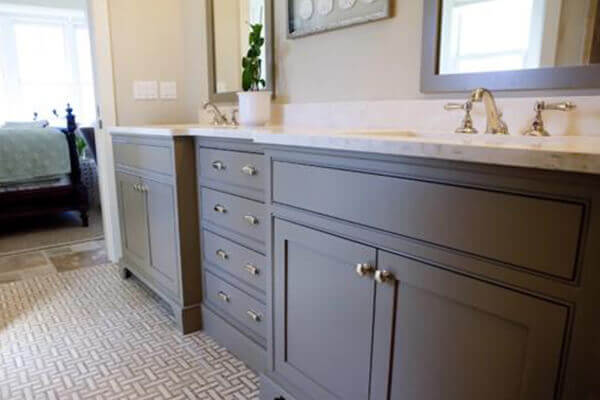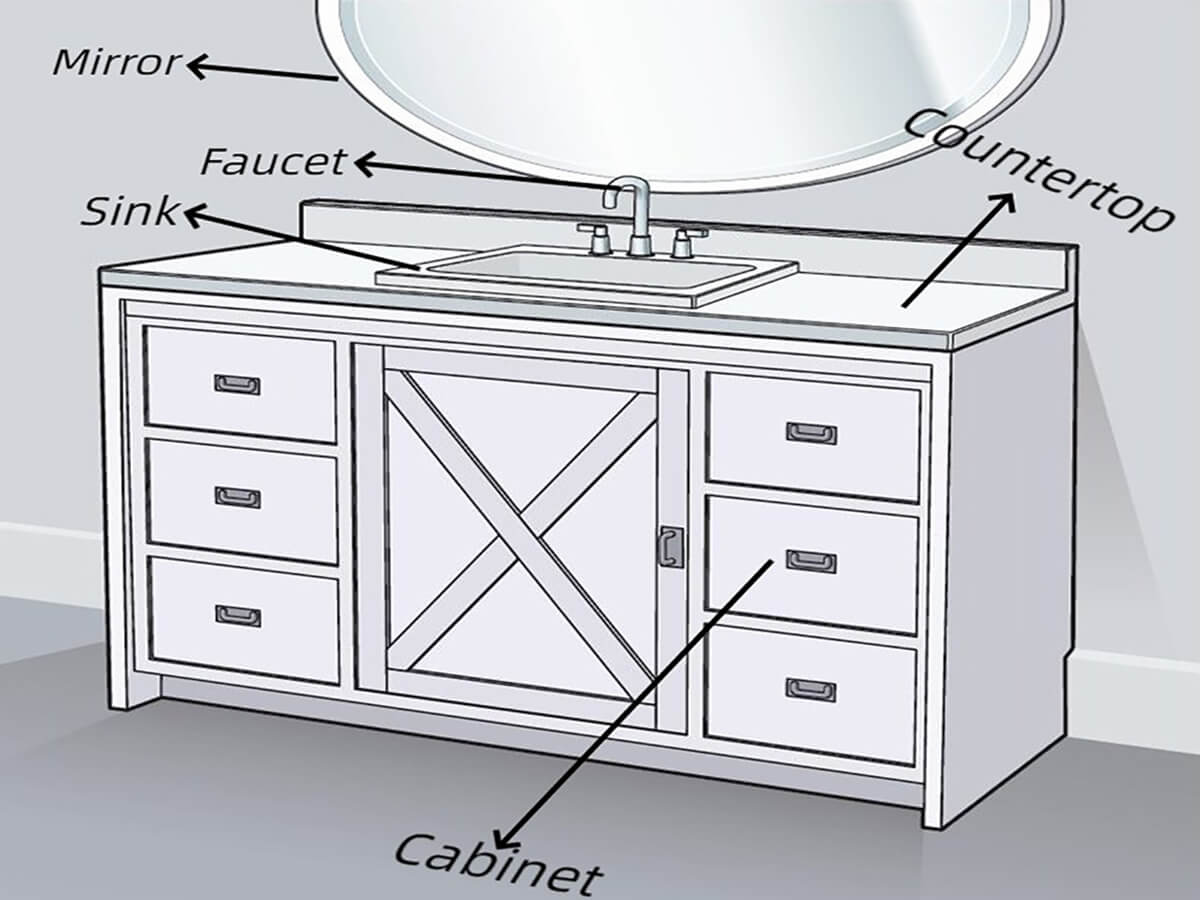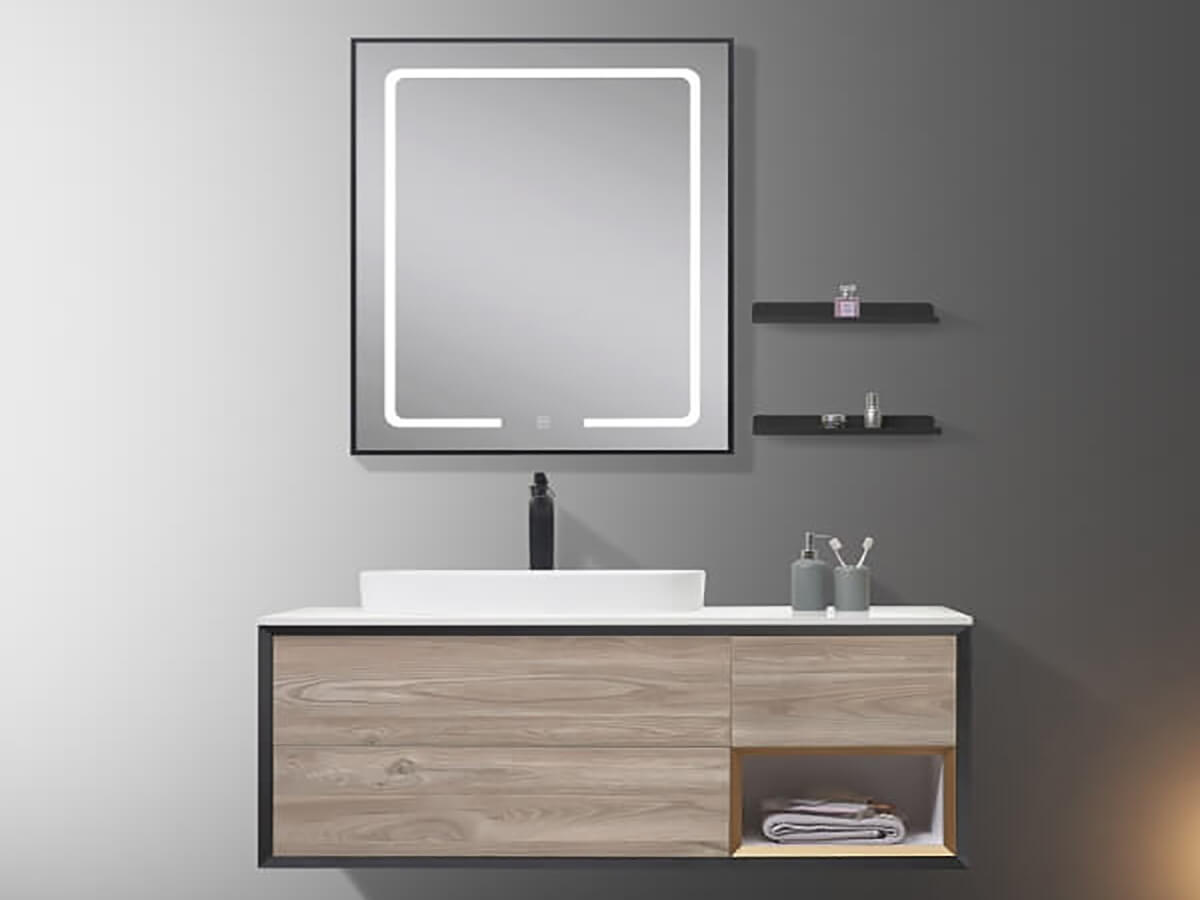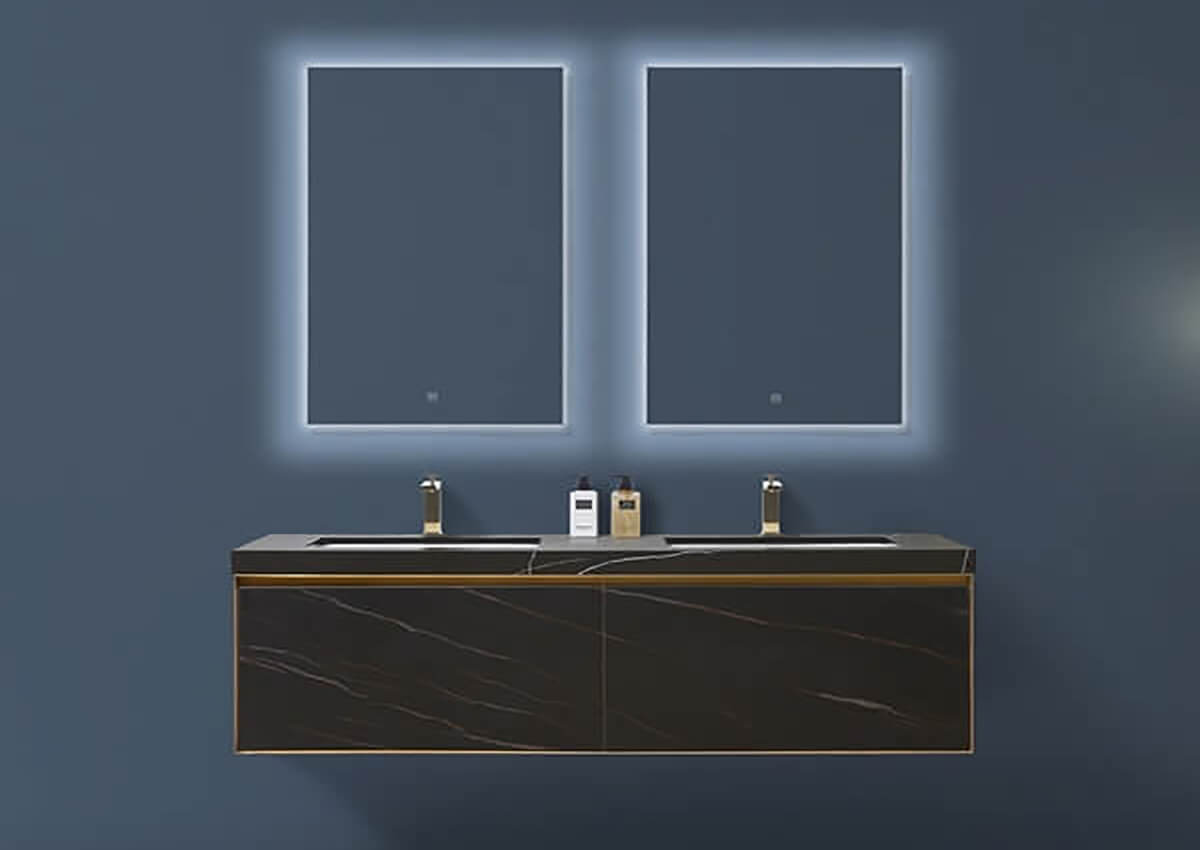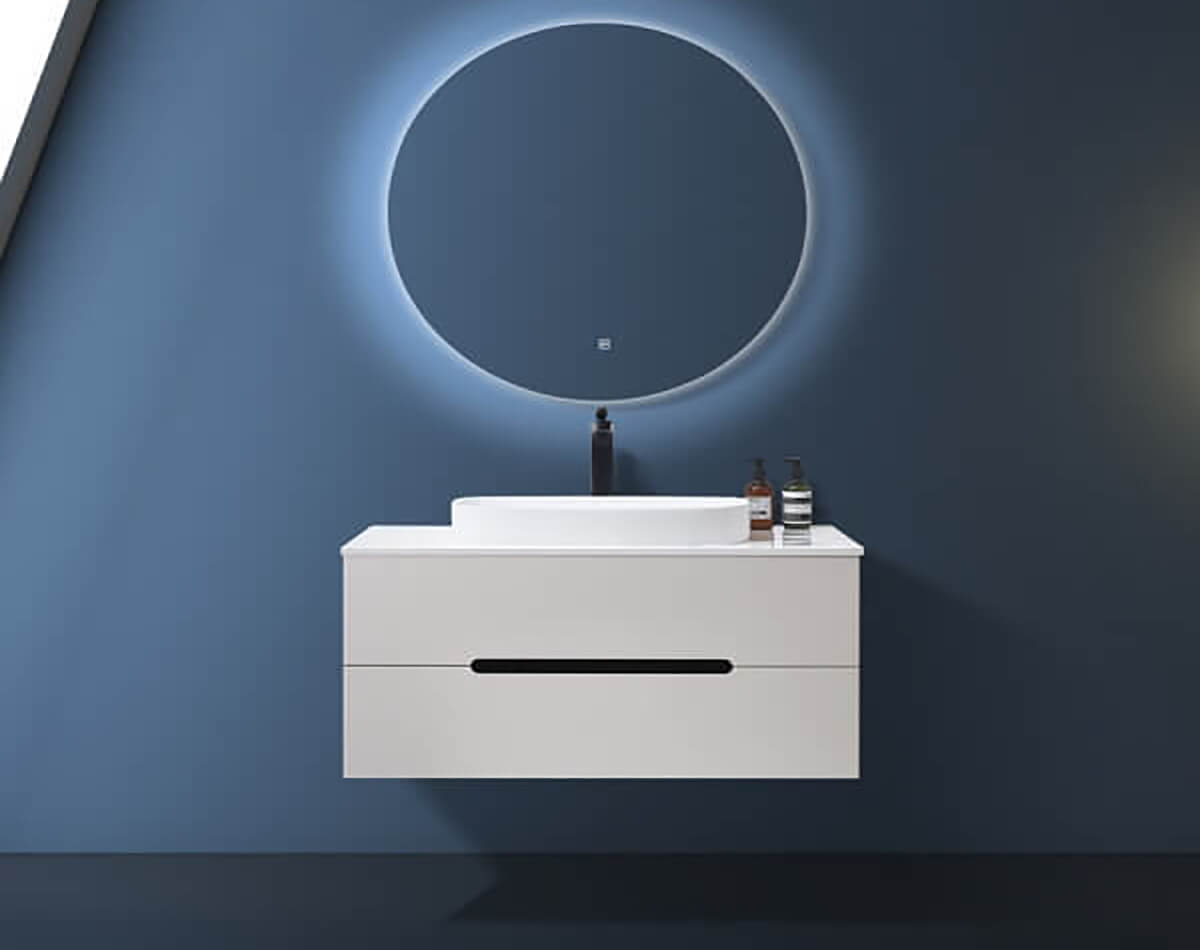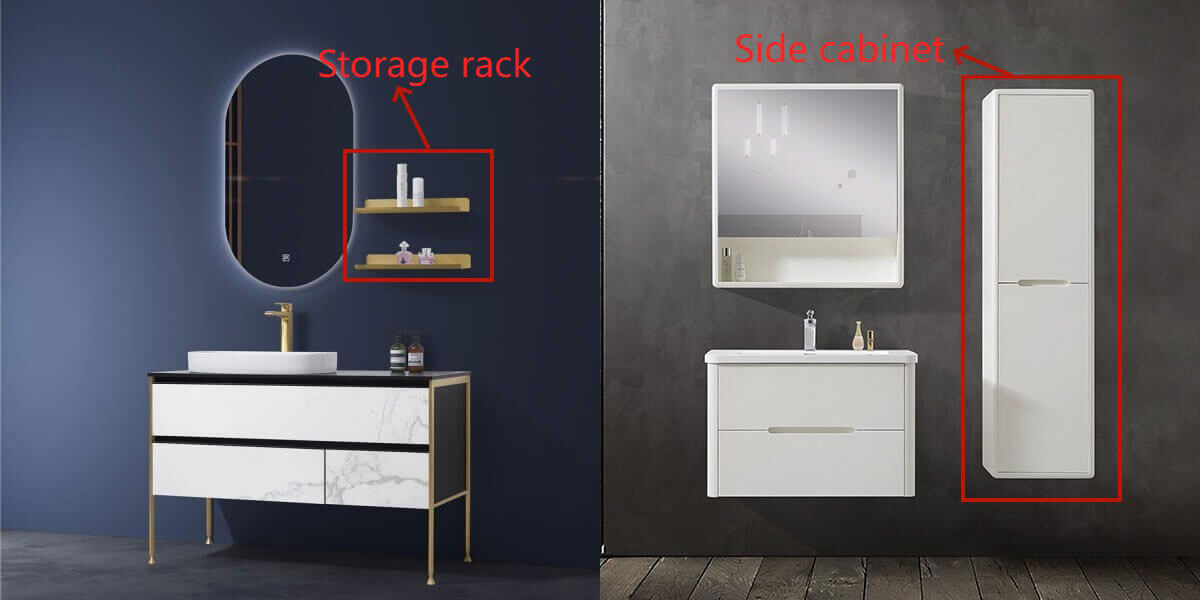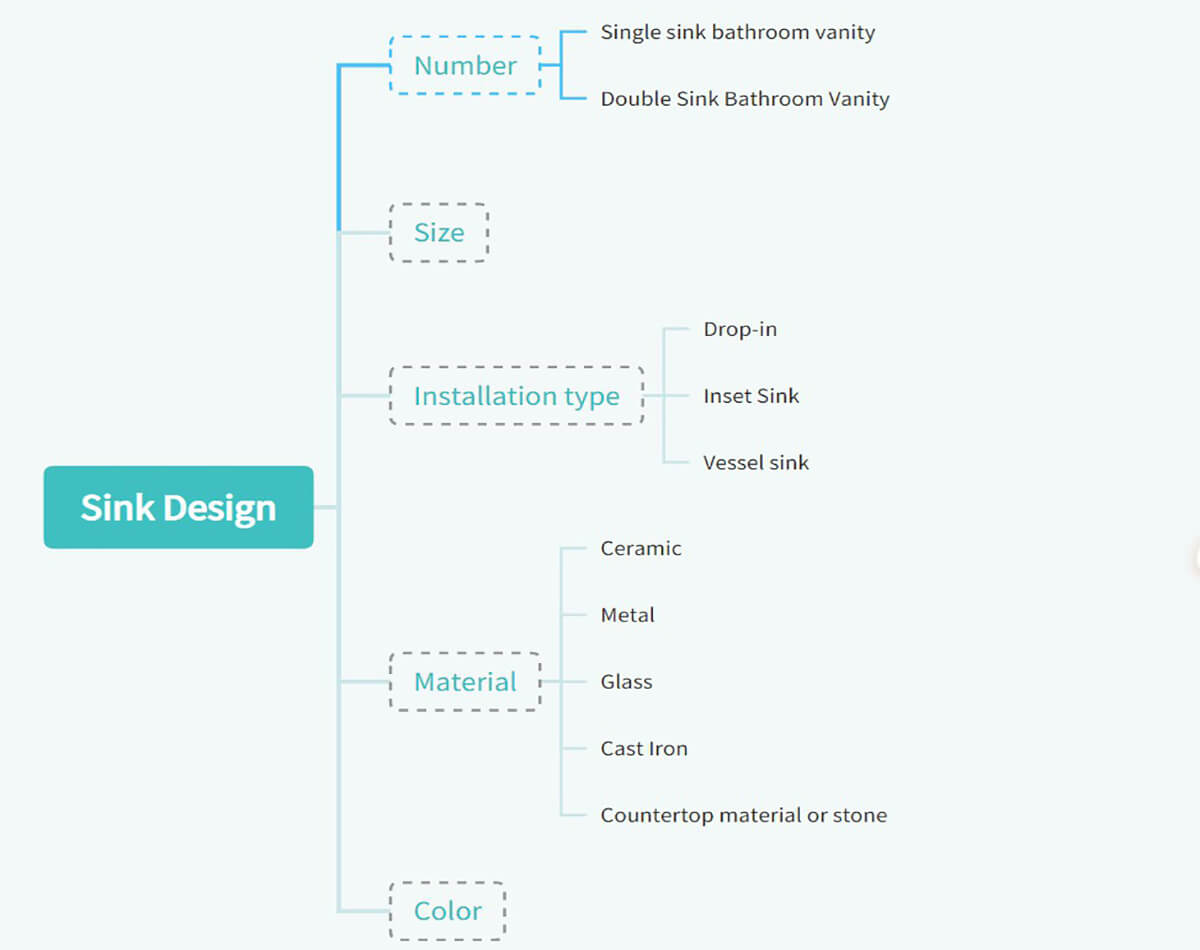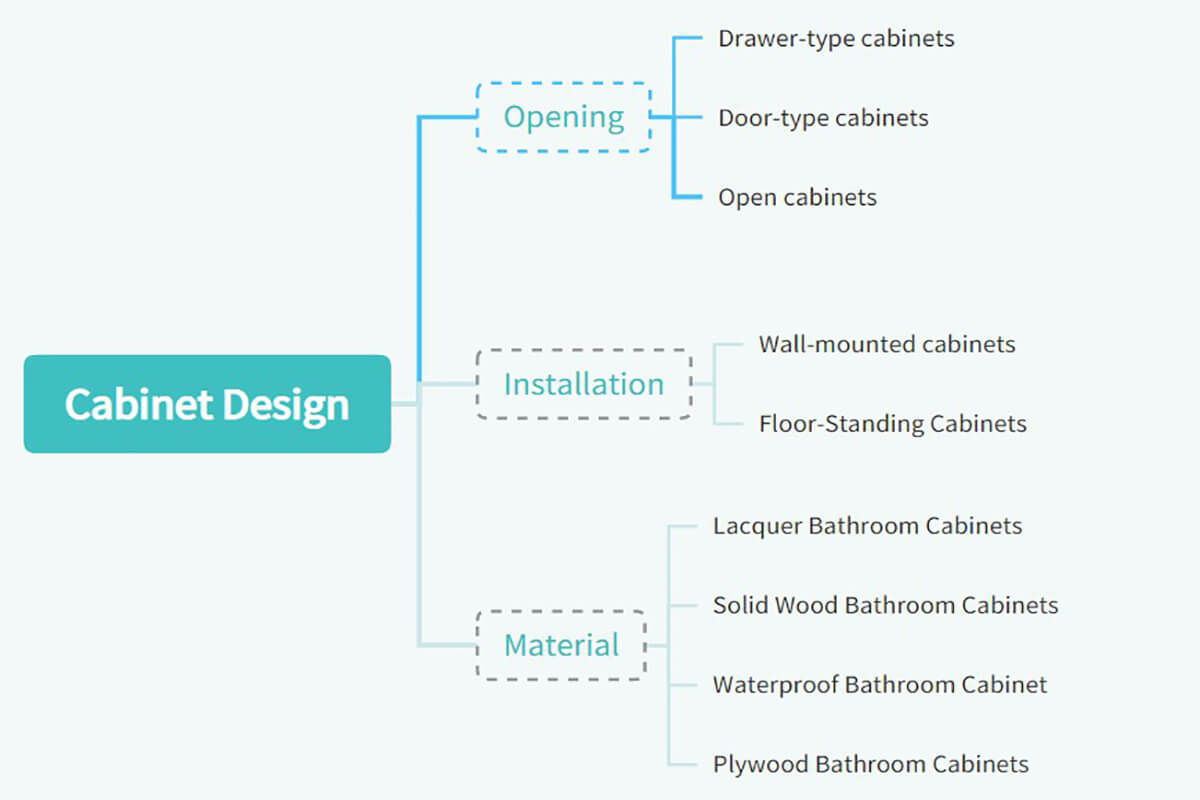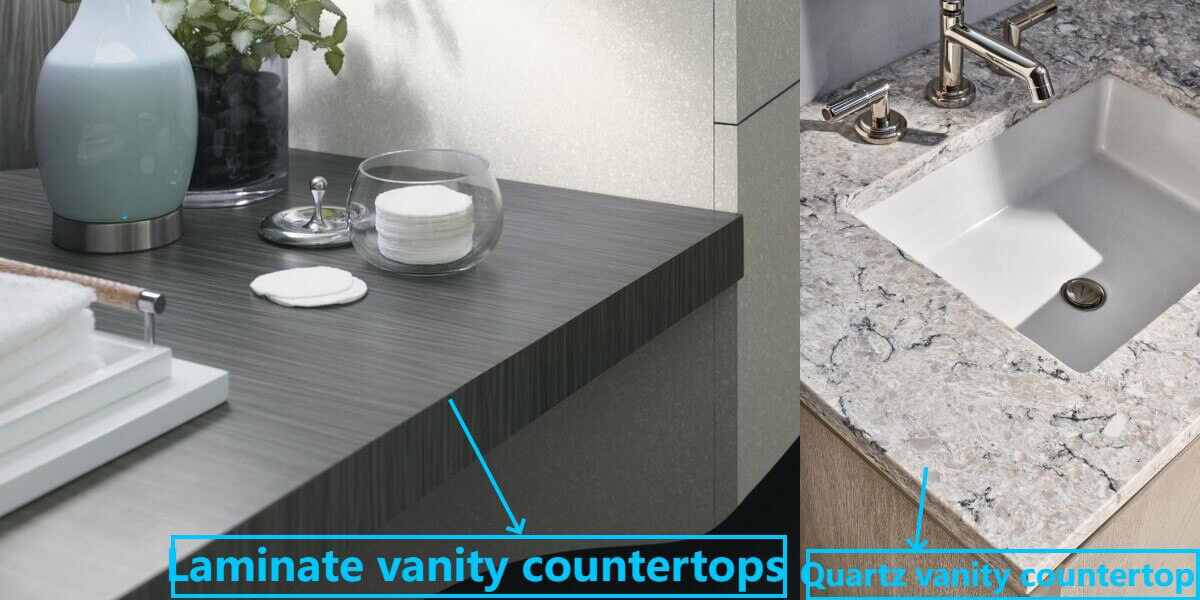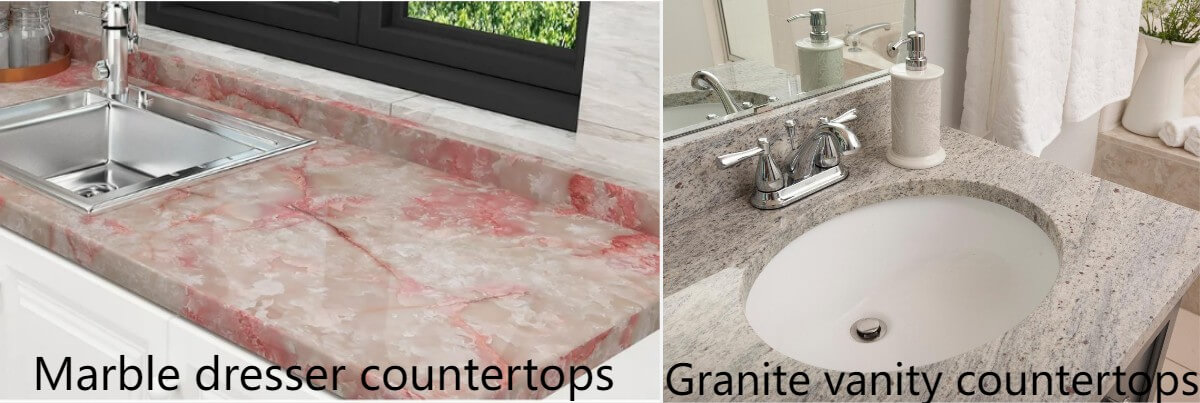As a bathroom vanity manufacturer, in most cases, we manufacture vanity according to clients’ bathroom vanity design drawings. Sometimes, we need to help the clients to fix the design together. In this article, Nicemoco will tell you how to design a bathroom vanity step by step.
1. Bathroom vanity structure
Before you design a bathroom vanity, you should know the structure of a bathroom vanity. Although bathroom vanities have different materials and functions, the structure is the same. A traditional bathroom vanity is usually made of a sink and a cabinet, it solves two main problems, washing and storage. As people’s demands for beauty become higher and higher, vanity designers add mirrors to it. So your bathroom vanity should cover the sink, cabinet, and mirrors. Now let’s start:
2. Fix the design layout
You should start your design job by writing a layout, your bathroom vanity should fit your bathroom. According to the bathroom space, different types of bathroom vanities can be chosen. So use a ruler to measure your bathroom first, you should exactly know what size your vanity is.
Here are some common choices for different spaces:
- Single Bathroom Vanity: This is the common style of bathroom vanity, it suits normal-size bathrooms.
- Double Bathroom vanity: it has two cabinets, two sinks, and mirrors, wider than a single vanity. It is often used in public washrooms, however, some large bathrooms often choose it.
- Corner bathroom vanity: this triangle-style vanity is often used in small bathrooms, like the master bedroom bathroom
Besides, your design is also affected by its function, for example, if you want your vanity mounted on the wall, you should consider the space under the cabinet.
(Another related post: A Complete Guide to Buying Bathroom Vanity)
3. Choose a style
Once you have determined the size of your bathroom vanity, the next step is to decide on the style of your bathroom vanity. Bathroom vanities come in a variety of styles. You can design the specific style of the bathroom vanity according to the overall style of the bathroom or your favorite style. The following are several common styles provided by Nicemoco for your reference.
1)Hotel Bathroom Vanity
Hotel bathroom vanities have a sophisticated yet minimalist style that is perfect for bathrooms with a more open-plan design. Provides ample space to store and organize cosmetics, toiletries, and other bathroom essentials.
Features:
- Environment Certification: E1
- Practical Wall-Mounted Design
- Large drawers and open storage space
- Button invisible handle & pop-up opening and closing drawer
- Waterproof, easy to clean, scratch-resistant
- Simple and stylish modern design
- DTC soft closing Slide(Chinese Top Brand), Silent operation, smooth sliding
- U drawer with U-shaped ABS wall fitted around the plumbing, separating toiletries from the plumbing for a tidy look
2)Minimalist Bathroom Vanity
Minimalist bathroom vanities are perfect for those who want to create a simple, clean aesthetic in their home. The cabinet’s minimalist design makes it easy to match any existing decor.
Features:
- Environment Certification: E1
- Practical Wall-Mounted Design
- Waterproof, Easy to clean, Scratch-resistant
- Beautiful and elegant modern design
- A 45-degree oblique invisible handle and curved handle make this a beautiful and easy-to-use bag
- DTC soft closing Slide(Chinese Top Brand), Silent operation, smooth sliding
- U drawer with U-shaped ABS wall fitted around the plumbing, separating toiletries from the plumbing for a tidy look
- Unique multiple drawers design drawer with a concealed inner drawer, providing Extra storage space
3)Luxury Bathroom Vanities
The sleek, modern design of the luxury bathroom vanity is perfect for any bathroom, and the durable materials are easy to clean and maintain. This vanity is sure to give your bathroom a stylish and modern look.
Features:
- Environment Certification: E1
- Practical Wall-Mounted Design
- Versatility, beauty, practicality and affordability
- Large drawers with big storage spaces.
- 45 oblique invisible Handle
- U drawer with U-shaped ABS wall fitted around the plumbing, separating toiletries from the plumbing for a tidy look
- DTC soft closing Slide(Chinese Top Brand), Silent operation, smooth sliding
4)European Bathroom Vanity
The sleek, modern design of the European bathroom vanity is perfect for any bathroom, and the spacious shelves provide ample storage space for all your needs. The European modern floating bathroom vanity is the perfect addition to any home!
Features:
- Environment Certification: E1
- Practical Wall-Mounted Design
- Versatility, beauty, practicality and affordability
- Large drawers with big storage space
- Curved handle, beautiful and easy to open and close
- U drawer with U-shaped ABS wall fitted around the plumbing, separating toiletries from the plumbing for a tidy look
4. Determine functionality
The fourth step is to determine the function of the bathroom vanity. A complete bathroom vanity is composed of multiple accessories, and the different functions of each accessory determine the overall function of the bathroom vanity. So you can choose the function of each accessory according to your needs. Here are some of the features of the different accessories.
1) Mirror
The mirror is an essential part of the bathroom vanity. Depending on the different functions of the mirror, you can have the following options when designing your bathroom vanity:
#1. Smart mirror
Smart mirrors have integrated displays behind the glass and are two-way mirrors. There are many things you can display on the mirror surface, including the current time, weather forecast, news feed, and upcoming appointments. You can even add voice commands using Amazon’s Alexa or Google’s Home Assistant. With voice commands, you can ask the mirror questions, set reminders, or control other smart devices in your home. The thing about a bathroom vanity with a smart mirror is that you can use modern technology to conveniently operate the mirror without even using your hands.
#2. LED light mirror
LED mirrors are mirrors that contain LED bulbs that illuminate their surface. They can be integrated into mirrors in a number of different ways. For example, there are backlit designs, as well as designs with simple light bulbs on the side of the mirror. The function of a bathroom vanity with an LED light mirror is that it provides bright and even lighting, perfect for applying makeup, shaving, or performing any other beauty tasks. These lights are long-lasting and can be adjusted to different brightness levels to suit your preference.
#3. Anti-fog mirror
Anti-fog bathroom mirrors contain a heating element that, when turned on, prevents the build-up of condensation that can occur when taking a bath or shower or running a hot water tap over the basin. The end result is that you should always be able to see a clear reflection. The function of a bathroom vanity with an anti-fog mirror is that no matter how foggy your bathroom is, you can use the mirror with peace of mind.
2) faucet
The faucet is the water outlet device of the bathroom vanity. Depending on the different functions of the faucet, you have the following common options when designing your bathroom vanity.
#1. Ordinary faucet
Ordinary faucets only have the function of discharging water and do not have other functions, such as adjusting water temperature.
#2. Faucet with adjustable water temperature
Currently, most faucets on the market have the function of adjusting water temperature. For example, single-handle faucets, double-handle faucets, hot water faucets, boiling water faucets, etc. A bathroom vanity with an adjustable water temperature faucet makes it very convenient to enjoy a warm stream of water, even during the cold winter months.
#3. Smart faucet
Smart faucets are automatic faucets with electronic sensors. These sensors turn the water flow on (and off) when motion is detected, so you don’t have to turn the faucet knob. Most include hands-free operation via touch or motion, and some are even voice-activated. Of course, the function of a bathroom vanity with a smart faucet is to allow you to experience touchless control of the flow of water. This is very convenient, especially when your hands are covered in soap.
3) Storage rack
When designing your bathroom vanity, consider whether you need one or two additional shelves. The function of this shelf is to place some frequently used items for easy access or to place some of your favorite bathroom fragrances.
4) Whether there is a side cabinet
If you feel like you have more bathroom items then you have enough storage space in one vanity to accommodate them. Then you can consider whether you need to design a side cabinet. A bathroom vanity with a side cabinet can increase storage space. Of course, you can choose to design this side cabinet as wall-mounted or floor-standing. Please note that when designing, consider how it will match your dressing table.
5. Sink design
The sink is an important part of the bathroom vanity, and all bathroom sinks serve the same function, bringing water into and out of the space. However, sinks with different designs can give you different experiences. Let’s take a look at the factors to consider when designing a bathroom vanity sink.
1) Number of sinks
Common sinks are divided into single sinks and double sinks.
Single sink bathroom vanity: A single sink means that the bathroom vanity has only one sink for one person to wash. Bathroom vanities with single sinks are suitable for people who live alone or are single.
Double Sink Bathroom Vanity: Of course, a double sink bathroom vanity is a bathroom vanity with two sinks. It can accommodate two people washing at the same time, which is suitable for cohabiting couples or married families.
2) Size of sink
Bathroom sinks come in many different sizes. In a compact bathroom, powder room, or half bath, the size of the room may determine the size of the sink that will fit in the space.
3) Sink installation type
Drop-in: A top-mount sink that “drops” directly into an existing hole in a countertop or vanity. These are usually the easiest to install and can be installed on any type of countertop.
Inset Sink: An under-mount sink is installed at the bottom of the countertop. The advantage of this kind of under-counter basin is that it is not easy to accumulate dirt and makes it easy to clean the countertop.
Vessel sink: A vessel sink is located above the counter. Cut a drainage hole in the countertop. There’s a lot to clean, but vessel sinks allow you to choose sinks with patterns, designs, and custom shapes.
4) Sink material
Ceramic: Ceramic clay material. Very common and easy to clean and maintain.
Metal: Made of stainless steel, copper, and brass. Very durable and not easily damaged. Can reveal hard water spots.
Glass: Tempered glass increases strength and durability. Hard water spots can also be revealed.
Cast Iron: Made of enameled cast iron. A variety of shapes and colors are usually available. Easy to maintain, but may rust if the enamel is damaged.
Countertop material or stone: Integral sinks can be made from the same material as the countertop, or they can be made from stone such as concrete and other natural stones.
5) Sink color
Bathroom sinks are available in a variety of colors to complement or make a statement in any bathroom. The material and type of installation of the sink may determine the colors available for each specific sink.
(Another related post: How to Care Bathroom Vanity?)
6. Cabinet design
Cabinets serve as storage space for bathroom vanities. Depending on the different functions of the cabinets, you have the following options when designing your bathroom vanity.
1) Divide according to opening method
Drawer-type cabinets: Drawer-type cabinets are opened by pulling out. If necessary, you can add a lock to the drawer cabinet to protect your privacy.
Door-type cabinets: As the name suggests, door-type cabinets open the cabinets by pushing and pulling like a door.
Open cabinets: Open cabinets do not have any baffles to close off the space, so you can reach what you want just by reaching out.
2) Divide according to installation method
Wall-mounted cabinets: Wall-mounted cabinets are cabinets that are fixed on the wall and do not fall to the floor. The function of this kind of cabinet is to save a lot of space, which is very cost-effective, especially for small bathrooms. The free bottom space can be used to place some washbasins or footbaths.
Floor-Standing Cabinets: Floor-standing cabinets have leg supports. This kind of bathroom cabinet is generally large and suitable for families with large bathroom areas. Its main function is to store a lot of bathroom supplies.
3) Divide according to material
There are many different materials for cabinets to choose from. Let me take a look at the different materials of bathroom cabinets provided by Nicemoco.
#1. Lacquer Bathroom Cabinets
The surface of Lacquer cabinets is painted with a layer of paint to make the bathroom cabinets look brighter and cleaner, and you can paint them in your favorite color. If you are looking for a simple and elegant wall-mounted modern bathroom vanity, then you can check out Nicemoco’s lacquered bathroom vanity. Clean colors give people a sense of tranquility, and lacquerware makes the whole room bright and clean.
#2. Solid Wood Bathroom Cabinets
Solid wood is often considered the most durable option for traditional vanities. But since wood expands as heat increases and absorbs moisture. So if you choose solid wood cabinets, be sure to control the humidity in your bathroom with the help of an exhaust fan and dehumidifier.
#3. Waterproof Bathroom Cabinet
Obviously, the difference between water-discharging bathroom cabinets and other bathroom cabinets is that they are waterproof. Nicemoco’s waterproof bathroom cabinets are perfect for anyone who wants to add a modern touch to their home. The wall-mounted design makes it easy to install, and the solid wood construction ensures durability and stability.
#4. Plywood Bathroom Cabinets
This material is a board made of wooden boards that are glued together. It comes in various qualities and thicknesses. Solid plywood is an ideal choice for homeowners looking for a durable and cost-effective material. It can withstand expansion and contraction caused by moisture accumulation and temperature changes. The sleek design of the plywood cabinets supplied by Nicemoco complements the black sintered stone drawer surfaces to create a modern and chic look.
(Another related post: Top 10 Chinese Bathroom Vanities Manufacturers in 2023)
7. Find the right countertop
Bathroom vanity tops need to be waterproof, easy to clean, affordable, durable and, of course, attractive. Some bathroom vanity tops meet these standards, such as laminate, quartz, solid surface, tile, and stone. But if you want something different, some less commonly used materials like concrete and broken glass can still provide unique, eye-catching alternatives. Below are some common bathroom vanity tops.
1) Laminate vanity countertops
Laminate countertops are made from multiple layers of plastic bonded to a particleboard (MDF) core to create a solid countertop surface. Stock countertops are uniform and can be cut and installed by anyone.
Advantages of laminate vanity countertops:
- Cheap
- light
- Suitable for DIY
2) Quartz vanity countertops
Quartz is generally the first choice for bathroom vanity countertops. Quartz is heat-resistant, scratch-resistant, and available in a variety of different colors.
Advantages of quartz vanity countertops:
- Solid, non-porous surface
- Low maintenance and easy-to-clean
- Heat-resistant, scratch-resistant and stain-resistant
3) Marble dresser countertops
Marble comes in three forms: artificial marble, engineered marble, and natural marble. One of the most fascinating aspects of marble countertops is that each slab is unique, like all natural stone products, and will truly stand out in your bathroom. When designing your bathroom vanity you can further customize your marble countertops using a variety of colors and shades.
Advantages of Artificial and Engineered Marble:
- Nonporous
- Moisture-proof, dirt-proof, heat-resistant and bacteria-proof
- seamless
- Low maintenance and easy-to-clean
- Can be shaped and customized
- Natural marble offers high-end look at a fraction of the cost
Advantages of natural marble:
- Provides an elegant look
- outstanding veins
- natural cooling effect
- Heat resistant (like hot curling irons)
- Easy to clean if properly sealed
4) Granite vanity countertops
Granite bathroom countertops are extremely durable and stain and bacteria-resistant. They are easy to care for and bring a timeless look to any bathroom. They come in a variety of colors and no two granite vanities are the same. To extend the life of your granite vanity, reseal it every 12 to 18 months.
Advantages of granite vanities countertops:
- Anti-scratch, heat and moisture resistant
- Sealed to prevent stains and bacteria
- Extraordinarily powerful
- Easy to maintain
5) Broken glass vanity countertops
Countertops made from broken glass are a relatively new product, but they are slowly becoming more popular. These countertops are made from recycled cullet glass embedded in clear acrylic or concrete.
Advantages of broken glass vanity countertops:
- Moisture-proof and dirt-proof
- Extremely durable
- Has a sense of design
6) Ceramic or tile countertops
Ceramic tiles are made of clay and are coated with a glaze; they are heated by fire to harden them. High-temperature firing results in finer clay in ceramics.
advantage:
- Cheap
- Suitable for DIY
- Wide range of designs
When designing a bathroom vanity, considering the material of the bathroom vanity countertop is an important factor. You should consider what is most important to you. In terms of appearance, granite and quartzite are good choices. For durability and ease of cleaning, quartz is a good choice. If you are looking for low maintenance and low cost, then consider laminate or cultured marble.
8. Conclusion
The above is how to design a bathroom vanity step by step organized by Nicemoco. Please remember that the most important thing in designing is to decide according to your own preferences. Be it style, materials, or functionality. If you have any further questions, please feel free to contact Nicemoco.
How useful was this post?
Click on a star to rate it!
Average rating 5 / 5. Vote count: 4
No votes so far! Be the first to rate this post.





